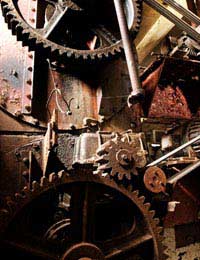
Amateur historian Michael Rix, introduced the term Industrial Archaeology (IA) to academic centres in 1955, as the title of one of his written articles. The phrase is so new to archaeological science that there remains no fixed definition acceptable to all of the sub-disciplines.
For 50 years those who claim to be industrial archaeologists have proposed many bewildering descriptions and definitions, but the date range it is said to cover is as short as only the last 100 years, to as long as ancient historical records permit – some 6000 years. It is not only the date range that is debated but also the very purpose and use of such a study is hotly contested.
From its inception in the 1950s museum based archaeologists, who had already adopted the term themselves, assisted the Council for British Archaeology to establish a dedicated IA research committee in 1959 who applied the term to mean the physical remains of the Industrial Revolution.
The Industrial Revolution
If IA is to be conducted with a view of studying the evolving manufacturing processes throughout human history then it must rightly include the development of stone axes and flint knives of the Neolithic period up until the present.
Many of the industries of the 18th and 19th centuries have declined into near obscurity and with it the loss of historically valuable trades and practices. Historical visionaries recognised the immense importance of regaining knowledge of the dormant iron foundries, ports, stations, and other transport hubs, textile mills, and shipbuilding yards. Their commitment forged a general acceptance that IA means archaeological study of the period of the Industrial Revolution to the present day.
Techno-Centred Theory
A technologically centred approach to IA remained through the 1990s where the emphasis lay in studying the mechanical nature and physical character of single industries. Given the sheer number of potential excavation sites and the massive volume of the archaeological record it was quite understandable that the trend was toward a techno-centric approach without synthesis.
Later refinements in IA theory included the key social feature caused by industrialisation: the consequences of amassing human populations in urban societies and the depletion of the rural sector.
With this theoretical inclusion came the beginnings of excavations in urban wastelands, the hitherto undesirable, abandoned sites of redundant heavy industry. Soon, archaeologists were unearthing not only past manufacturing remains but the homes and offices of the people who worked there.
This enlightened approach provided an ability to incorporate new archaeological methodologies and to alter existing sub-branch models to mould a new and distinct archaeological discipline.
Fields of Investigation
Industrial archaeologists have at least four major topics of interest that fashion the direction of their research. They are transport, energy, metals, and manufacturing processes.
- Transport
Transport improvements delivered more raw materials cheaper and faster and permitted continuous production. Conversely, finished product could be routed quicker and more cost effectively to a wider customer base than ever before. IA’s are searching for material transport remains and evidence of their development.
- Sources of Energy
Powerful energy resources lay in undisturbed subterranean treasure chests. Valuable seams of high-grade coal powered a hungry revolution of steam engines that drove industry to new heights.
High-speed, steam powered, machinery quickly replaced the slow unreliable water wheels that had attracted textile mills for centuries along fast flowing rivers. Rivers were dammed for hydro power stations. IA’s will perform geophysical surveys to determine human interference to natural waterways and locate mines.
- The Demand for Metals
The industrial revolution relied on a unique combination of natural resource dynamics. Along with the need for rich fuels was the demand for machinery and construction metals such as iron and lead. Lead was required throughout the plumbing and building trades, most often consumed in weighty quantities on roofs, guttering, and downpipes. Most metals from the industrial period especially lead have lasted well. IA’s will excavate the architectural remains and study the relics and machine artefacts that reflect the industrial revolution.
- Manufacturing Processes
Textile production involved a series of highly specialised trades like printers, dyers, and bleachers. Vegetable dyes needed alum to make the yarn colour fast. The use of synthetic colours and better sources of shale-alum made the textile industry more reliable and consistent.
In Europe’s damp, wet conditions, textile remains are difficult to find. However, with modern methods the IA is able to preserve what little is left in the archaeological record.
Don’t Leave Home Without Your Mac
One good illustration of industrial archaeology is found at the Macintosh Mill in Manchester, England. The factory, that had its beginnings in 1818, nearly two hundred years ago, and is a remarkable treasure of buried history. Scottish born inventor and chemist, Charles Macintosh, researched the technique of bonding India rubber to ordinary fabric to form a waterproof material.
Industrial archaeology seeks to discover, preserve, and display the dramatic changes that fashioned society during the industrial revolution.